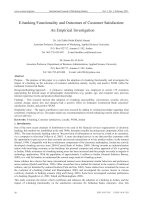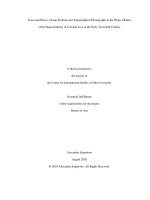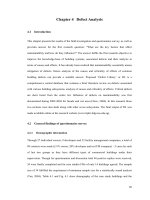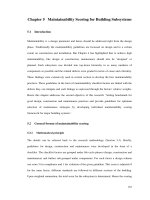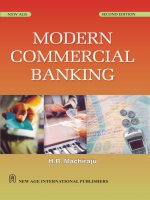GROUP ASSIGNMENT course title commercial banking TOPIC customer centricity of agribank
Bạn đang xem bản rút gọn của tài liệu. Xem và tải ngay bản đầy đủ của tài liệu tại đây (389.16 KB, 41 trang )
Banking Academy
Advanced Program
GROUP ASSIGNMENT
Course Title: Commercial Banking
TOPIC: Customer Centricity of Agribank
Instructor:
Dr. Le Hai Trung
Prepared By:
Tran Lan Anh
Nguyen Thi Lan Anh
Nguyen Khanh Linh
Nguyen Thi My Duyen
Nguyen Phuong Linh
Nguyen Thi Kim Lien
Ha Noi, tháng 12 năm 2021
22A40105
99
94
40
25
11
51
22A40104
22A40104
22A40105
22A40106
22A40107
TABLE OF CONTENT
I.
II.
CONSUMER CENTRICITY OF AGRIBANK
III.
I. INTRODUCE ABOUT AGRIBANK
IV.
Agribank was established on March 26, 1988 under Decree No. 53/HDBT of
the
Chairman of the Council of Ministers with the name of Vietnam Agricultural
Development Bank. After that, the Bank changed its name to Agricultural Bank of
Vietnam according to Decision No. 400/CT dated 14/11/1990 of the Prime Minister.
According to Decision No. 280/QD-NH5 dated November 15, 1996, the Bank
changed its name again to the Bank for Agriculture and Rural Development of
Vietnam as it is today. On January 30, 2011, the State Bank of Vietnam (the State
Bank) issued Decision No. 214/QD-Ngan , approving the transformation of ownership
form of the Bank for Agriculture and Development. Rural Vietnam from State-owned
enterprises to one-member limited liability companies owned by the State. Agribank is
the bank in the BIG 4 banks in Vietnam. This bank is mainly invested in agricultural,
farmer and rural development.
SERVICE REVENUE STRUCTURE 2020
V.
1.
VI.
payments and
remittances
Services and products
International
VII.
4,000,000
IX. VIII.
Up to now, Agribank has provided more than 200 products and Services to
corporate customers, household customers, and individuals, and to credit institutions
and íinancial institutions in the market, capital market, open market, interbank market.
XI.
Products and services are divided into groups, including: Capital
mobilization
products; Group of domestic payment services; Card service group; Group of
international payment services; Service Group Forex Trading; Remittance Service
Team; E-Banking service group E-Banking; Treasury and money management
services group; Agency entrustment service group; Group of associated products and
services;...
XII.
Besides, service fee revenue continued to have good results; safety ratios are
guaranteed according to regulations of the State Bank. Agribank continues to affirm
the steadfastness of a brand associated with the mission of agriculture, farmers and
rural areas, always being a pioneer, the main source of credit, convenient products and
services for the economy.
XIII.
In terms of network operation: Agribank's network system is very large, this
is
an advantage when providing banking products and services, especially payment
services, and is a necessary basis to increase convenience. and meet the increasing
needs of customers. Currently, Agribank has relationships with nearly 740 banks and
bank branches in more than 86 countries and territories with nearly 2,300 branches
and transaction offices, the largest automated banking network (more than 3,000
ATMs, 80 CDM and over 24,500 POS machines serving over 12.6 million cards).
X.
XIV.
About the number of products and services provided in the market:
Currently,
Agribank has more than 200 products and services, contributing to diversifyingproducts,
increasing income, and meeting the needs of diverse customers. The bank
also developed strongly in insurance - banking products. Products and services for
individual and institutional customers are divided into 10 groups: Capital
mobilization, credit, domestic payment, international payment, Treasury, investment,
card, E-Banking, banking services fund and money management, meeting the best
needs of customers.
XV.
In addition, Agribank has received support from the Government and
international organizations such as the French Development Agency (AFD), the Asian
Development Bank (ADB) to sponsor many agroforestry development projects. This
is a favorable condition, providing many products and services to each object with
many incentives, ensuring the beneíits between the parties.
XVI.
About the brand and quality of service: The care and support for customers
is
done methodically and professionally by Agribank. In particular, in 2019, Agribank
improved the quality of products and services, added utility features, implemented
24/7 interbanking, online deposit, new payment services on E-Banking, etc. partners,
and met customer needs according to market trends.
2. Distribution channel
XVII.
In addition to developing products and services, Agribank focuses on
developing
distribution channels in line with the 4.0 trend. Agribank's distribution channels of
products and services are diversified including: Traditional product and service
distribution channels (2,233 branches and transaction offices, including: 158 grade 1
and 2 branches; 784 grade 3 branches and 1290 transaction offices; 7 companies).
affiliated; 03 representative offices and 01 foreign branch. Mobile transaction point);
Distribution channel via ATM and EDC/POS (2,626 ATM and 19,015 EDC/POS);
Distribution channel via Mobile Banking; Distribution channel via Internet Banking;
Distribution channel via payment connection with customers (CMS); Distribution
channel with correspondent banks (Agribank currently maintains agency relationships
with 825 banks in 86 countries and territories).
In order to increase the convenience of products and services, Agribank
XVIII.
offers
a
mobile transaction point by specialized car that provides customers with convenient
services such as: capital mobilization and lending, opening payment accounts and
registration. Sign to use the services on a payment account; domestic debit card;domestic
payment
Services;
bill
payment,
collection
and
payment
on
behalf
of;
payment of remittances, sale of ABIC insurance; E-Banking Services and other
convenient banking services of Agribank. As of June 30, 2021, Agribank has
deployed 68 cars in 66 branches, 454 communes, with 1,622,201 customers, 17,065
transactions.
XIX.
Currently, Agribank has issued more than 14 million active cards and has
always
maintained its position of the Top 3 commercial banks in the market with more than
3,000 ATM/CDM, more than 24,000 POS installed and distributed across the
provinces, remote areas of the country.
3. Swot model of Agribank
3.1.
XX.
Strengths
Agribank's biggest strength is the commercial bank with the largest equity.
This
bank is supported by the Government and development assistance funds of
international organizations such as ODA, AFD, and ADB to íinance projects on
agricultural and rural development, industrialization of agriculture, forestry and
íishery. . This makes Agribank a particularly important position in the country's
economic development; play a leading role in the rural íinancial market. However,
Agribank has absolute strength in the distribution channel network. With a wide
network, Agribank has its own advantages such as: stable market share, abundant
customers. In addition, Agribank has modern information technology infrastructure,
multi-function business, multi-industry, multi-field, a large and experienced staff.
3.2.
Weaknesses
XXI.
The first weakness of Agribank is not meeting the minimum capital
adequacy
ratio; íinancial sustainability is not high. Financial capacity is still weak by
international standards. Second, the branch network system in urban areas has not
been arranged and planned in a secure and effective manner. Infrastructure is not
synchronized leading to difficulties for the process of investment and perfecting high
technology. Third, products and services are not diversified, service quality has not
been paid due attention, and has not met the actual needs of consumers. Fourth,
theorganizational model at the Head Office is not streamlined and effective; lack of welltrained staff to meet the requirements of the new era. Finally, Agribank is heavily
iníluenced by the Government, operating completely not for profit, so its competitive
advantage has not been fully exploited.
3.3.
XXII.
Opportunities
Nowadays, Vietnam's deeper and deeper integration into the world economy
is
a
great opportunity for banks, especially Agribank. The rapid development of scientiíic
progress will give Agribank the opportunity to raise and improve the level of science
and technology. In addition, Vietnam is an economy that always achieves high
growth, but a stable and safe environment creates favorable conditions for the
development of the bank. But besides that, the banking industry is also under a lot of
pressure to maintain its role as an important capital conduit for the whole economy.
3.4.
Threats
XXIII. Vietnam's economy is integrating deeper and wider into the international
economy, both an opportunity and a challenge for the banking industry in general and
Agribank in particular. Challenges when Vietnam relaxes operating conditions for
foreign banks in line with Vietnam's implementation of WTO commitments, creating
competition between domestic and foreign banks. Not only that, among domestic
banks, there is also competition between state banks and joint stock banks. These
banks are increasingly dynamic, ílexible and responsive. However, products that
replace banking services are increasingly being perfected and become rivals and
heavyweights. Even within the bank itself, there are many difficulties when
implementing digital transformation in terms of synchronization and standardization
of technical infrastructure. Besides, the COVID-19 pandemic is a thermometer that
measures the "health" of the economy and the bank itself.
4. Bank performance
XXIV.
The Vietnam Bank for Agriculture and Rural Development (Agribank) has
just
released its separate íinancial statements for mid-2021. Despite operating in the
context of difficulties due to the impact of covid-19, with many synchronous and
effective solutions, Agribank has fulfilled its political mission and the role of
Vietnam's leading commercial bank. This bank is mainly invested in agricultural,farmer
and
rural
development,
with
the
proportion
of
"Tam
nong"
investment
accounting for 70% of the total outstanding economy, accounting for the largest
proportion of agricultural and rural investment credit market share in Vietnam
XXV.
Accordingly, at the end of the first 6 months of the year, the bank's pre-tax
profit
reached VND 9,464 billion, profit after tax was VND 7,572 billion, up 40% over the
same period, ranking third in the Big4 group after Vietcombank and VietinBank. The
main reason for the positive increase in bank profits is the reduction of operating
costs, increased debt recovery to handle risks, and all business segments of the bank
are profitable.
XXVI.
Specifically, accumulated in the first 6 months of the year, Agribank
continues
to
be the leading bank in terms of total operating income with VND33,581 billion, an
increase of nearly 32% over the same period. In particular, the main contribution is net
interest income with VND 25,973 billion, an increase of 29%. Interest income
increased by 3.9% while interest expense decreased by nearly 11% compared to the
same period in 2020, helping the bank's net interest income increase sharply.
XXVII.
As of June 30, 2021, Agribank's total assets reached more than VND1.6
million,
up 3.4% compared to the beginning of the year and up 10.5% compared to the same
period last year. In particular, customer lending reached VND 1,232,051 billion, a
slight increase of 1.6% compared to the beginning of the year and continued to lead
the market in credit market share. Customer mobilization reached VND 1,467,071
billion, an increase of 4.2%.
XXVIII.
In the context of Covid-19, Agribank has promptly implemented many
solutions
to support and solve difficulties for customers affected by the pandemic under the
direction of the Government and the SBV, such as restructuring the repayment term,
interest exemption, fees, and new loans.
XXIX.
In particular, restructuring, exemption of interest and fees for 12,500
customers
with outstanding debts of VND 30,109 billion, new loans of more than VND 203,000
billion to more than 50,000 customers. Agribank also implemented many creditprograms
with preferential interest rates, including: Doubling the limit of the customer
support program affected by the epidemic with the scale of VND 100,000 billion, the
interest rate, support fee up to 2.5% per year; preferential loans for small and mediumsized enterprises of VND 30,000 billion, supporting a maximum fee of 2%;
preferential loans for import-export customers of VND 15,000 billion and US$300
million; large-scale customer loans of VND 15,000 billion; consumer loans of VND
20,000 billion.
XXX. Index
XXXI. 6/2021
XXXII. 12/2020
XXXIII.
ROE
XXXIV.
10.17%
XXXV. 14.39%
XXXVI.
ROA
XXXVII.
0.47%
XXXVIII.
XXXIX.
NIM
XL.
XLII.
C/I
XLV. Equity multiplier
XLVIII.
XLIX.
1.6%
XLI.
0.68%
1.28%
XLIII. 3,75%
XLIV. 3,92%
XLVI. 4,62
XLVII. 4,725
Agribank's ROE and ROA indexes have declined compared to the end of
2020.
Agribank's ROE decreased mainly from declining ROA. Although both the difference
between deposit and interest rates (NIM) increased and the bank's ability to control
costs (C/I) ílourished, the ROA decreased sharply (nearly 30%) leading to ROE also
decreased. At that time, the government asked banks to reduce interest rates to support
citizens during the COVID-19 pandemic. Agribank had also offered its own support
packages to the people, so ROA reduction is inevitable. Thus, although Agribank's
ROE decreased, it did not really affect the proíitability of this bank. In the near future,
having overcome the COVID 19 pandemic, Agribank will likely grow strongly and
make more profit.
L.
LI.
LII.
Despite the decline, Agribank's business performance indicators are still very
positive compared to the Big 4 in particular and the banking industry in general.
Agribank's return on equity (ROE), surpassing that of Vietinbank (9.75%), reached
the highest with 10.17% in the Big 4. At the same time, the proíit margin on total
assets (ROA) reached 0.47% ranked second, only after 0.6% of Vietinbank. Non
performing loans (NPL) are a very important indicator in evaluating the performance
of a bank. According to statistics, the average NPL ratio in the íinancial statements of
Vietnamese banks is at 1.96% in 2020. In the second half of 2021, Agribank's bad
debts accounted for only 0.82% of total outstanding loans, the lowest in the Big 4
(BIDV: 1.39%, Vietcombank: 0.91% and Vietinbank: 1.38%) and decreased to nearly
0.9% compared to the end of 2020. The above indicators show that Agribank is
operating very well, the credit quality has improved significantly.
LIII.
Although the business results in the first 6 months of the year are positive, it
is
likely that Agribank's proíit for the whole year is unlikely to increase sharply. Covid
19 is taking place very complicatedly, a series of provinces and cities must be
separated in the third quarter of 2021, causing credit to slow down, bad debts tend to
increase, the recovery of bad debts through civil proceedings and handling collateral
will also be very difficult.
II. The Nature of Customer-centricity (thế giới/ VN nói chung)
1.
LIV.
LV.
Customer centric
Customer-centricity is a business strategy that puts the customer at the
center,
puts the customer first, the customer is the number one priority. Customer play an
really important role, they have direct impact on bank’s revenue. It is customer
understanding that is the foundation of customer-centricity. For banks, customercentricity is a banking practice based on trust and fairness, using customer knowledge
to meet their needs and achieve lasting relationships. , valuable, lasting.
LVI.
Roles of Customer - centricity
LVII.
For businesses that want to stay ahead, creating a customer-centric culture is
important. In fact, research by Deloitte and Touche shows that customer-oriented
businesses are 60% more profitable than those without a customer-oriented strategy.
LVIII.
Customer orientation creates a loyal customer community, which brings
more
revenue to the business in the long run. According to the Temkin Group, loyal
customers are 5 times more likely to purchase, 7 times more likely to buy new
products, and 4 times more likely to recommend your company to friends or family.
LIX.
In addition, customer-centricity plays a role in many other aspects:
LX.
Firstly, customer-centricity will help employees find meaning in their work,
increasing employee engagement with the business.
LXI.
Secondly, the customer-centric organization has good adaptability to the
market.
Changes in the market stem from a shift in customer needs and behavior. These
organizations are characterized by activities closely tied to their customer base. So
even the smallest changes are recognized quickly and strategies are updated promptly.
For example, during a pandemic, consumer behavior will shift from buying in-store to
home delivery. Customer-oriented businesses that can recognize this trend early and
promptly upgrade the quality of their website platforms and shipping services will
gain a great advantage over their competitors.
LXII.
Lastly, take the customer as the center to improve skills for personnel. HR is
encouraged to interact and maintain relationships with customers in a variety of ways.
As a result, their roles will be more diverse and their skills will be enhanced not only
in expertise but also in effective customer interactions.
LXIII.
With customer expectations at the highest level and competition from íintech
companies waiting to claim their market share, it is imperative that banks work to
understand their customers on a direct level. and please them at every opportunity.
While technology can help a bank achieve these goals, it still needs a solid customerfocused strategy to continue growing.
LXIV.
Today, banks are facing signiíicant challenges in terms of proíitability and
growth. Erosion of customer coníidence, slow economic recovery, and pressure from
various sources are among the many factors contributing to the current difficulties. In
the Americas, Europe, and Asia-Pacific regions, íinancial institutions have launched
marketing campaigns with slogans such as Banking Innovation, Restoring Trust, and
Deepening Banks. customer relationship. The goal is to make customers feel that their
banking needs are well taken care of - more "customer-centric".
LXV.
In the context of the "new normal" after the Covid-19 pandemic, customer
experience is a top priority. According to the Government's plan "National Digital
Transformation to 2025, Orientation to 2030", banking is clearly a field with social
impacts, related to people every day. Accordingly, customer-centricity is a key factor
in the digital transformation race of the banking industry.
LXVI.
Models
Image
Evoking emotion, human face,
engaged in socíety
Thorough, solid,
sĩrpple, no hassle,
fast, seamless
relationship-nninded
Sales process
Thorough reviewof needs,
counseling on best producí,
partner for long term
LXVIII. LXVII.
LXIX.
Three Patterns of Customer-Centiic Banking Are Emergíng
Communication
The patterns are observed consistencĩesEngaged
ĩn the approach
of tailored to
dialogue,
customer-centric banks and are not necessarily prescriptive
personal circumstances
and commitments
LXX.
Service (emotional)
Human, engaged, triendly,
Friendly and personal Service,
helpíủL supportive
suppórtive staff, engaged
Pricing to help
Image
Channels
Service cĩunctional) Easy interactỉon,
Products sìmple
Fair and relationship-based
Trusted paríner, fair
Efficient
executíon,
fast
resolution,
pricing, proactive suggestions
to
búy
Products,
áccess
at
counselíng,
protective,
Simple
to
ưse, fast
to start
and honést in giving
partnếring,
gets
thĩngs
right the first time
times
and places
of bétter alternatives
Meeting
Eítortless,
accessible,
Guardian
Convenience
up,
convenient
to desired
choose
customer
advice
2.
LXXI.
LXXII.
The importance of customer-centricity with Agribank
Customers are those who directly use the bank's products/services. The
mission
of
each bank is to bring the best and most useful products to meet the needs and
satisfaction of users. Customers play an important role in building a business strategy.
Banks need to base on their customer portraits to determine the goals of providing
products and care services that both satisfy customers and increase revenue.
LXXIII.
The importance of customers to Agribank is even more evident with the
goal
of
maintaining the position of the leading retail commercial bank in Vietnam, performing
well the key role of providing products and services (SPDVs), convenience and
convenience, banking interests in the íinancial-banking sector. Especially in the Tam
Nong area, which is diversiíied, modern, and high-quality based on digital technology
in the direction of customer-centricity, Agribank has implemented many incentive
programs, as well as increased many products. facilities that meet customer needs.
LXXIV.
farmers
With the motto "Rural is the market, agriculture is the loan object,
are
the
main customers", Agribank is trying to innovate day by day in the direction of
modernity, simplifying processes and procedures, applying digital banking to serve
many conveniences for customers, especially customers in rural areas.
LXXV.
areas
With a key role in the capital and credit markets for agriculture, rural
and
farmers, Agribank's activities are really associated with villages and hamlets and close
to farmers. Agribank's capital has created new jobs, restored traditional craft villages,
contributed to restructuring agriculture and rural areas in the direction of developing
goods, industry and services... Agribank has become a companion. close friendship,
effective capital support for farmers to rise up in production and business, creating
outstanding achievements in agricultural production and new rural construction. While
commercial banks "stick to" mainly in the city, Agribank always tries to find ways to
bring banking services to rural and remote areas of the country, contributing to push
back credit. black.
LXXVI.
Through programs, actions, improvements, and enhancement of the
quality
of
products and services as well as customer experiences, Agribank demonstrates its
determination to work with the banking industry to realize the National
Comprehensive Financial Strategy until the end of the year. 2025, with a vision to
2030 and the Government's projects (Development of non-cash payments for the
period 2016-2020; Improving access to banking services for the economy; Promoting
payment via banks) goods for public services); at the same time, implementing the
plan on digital transformation of the banking industry to 2025, with a vision to 2030.
III.Customer centricity in Agribank
What Agribank have done
1.1. Investment and developmentpolicy "Tam Nong"
LXXVIII.
As a bank likened to a "farmer's bank", Agribank has been making
LXXVII.
1.
efforts
to
bring banking and financial services to every village, commune, and family in rural
areas to realize a comprehensive financial strategy. nation.
LXXIX.
Agribank always promotes the pioneering role of a 100% state-
owned
commercial bank in seriously and effectively implementing monetary policy and
guidelines and policies of the Party and State, especially credit policy. serving
agricultural and rural development. By the end of 2020, Agribank has provided 1.6
million billion dong of capital for the economy, of which 70% of the outstanding
loans are for investment in agriculture and rural areas, accounting for nearly 50% of
the total outstanding loans of the bank. The entire banking industry invests in this
area.
LXXX. Implementing the State's policy, each year, Agribank spends thousands of
billion dong to apply preferential interest rates to agricultural production. Currently,
Agribank is effectively implementing a number of policy credit programs and 02
national target programs on new rural construction and sustainable poverty reduction.
LXXXI.
districts
Agribank has supported sustainable poverty reduction for 61 poor
with
loan turnover of over 13 trillion VND; loans under Decisions 63, 65, 68 on support
policies to reduce losses in agriculture with sales of nearly 15,000 billion dong; loans
to replant coffee with sales of over 1,300 billion dong; loans to íisheries development
policies under Decree 67 with sales of over VND 6,000 billion...
LXXXII.
For loans for new rural construction, Agribank has provided loans
to
100%
of
communes nationwide with outstanding loans of nearly VND 600 trillion, of which
over 50% of new rural construction loans are for investment. Production, Processing
and trading in agriculture, forestry, íishery and salt production to help raise the value
of key agricultural products; nearly 35% of investment capital for commercial
services; over 15% of investment capital to build rural infrastructure...
LXXXIII.
Through the implementation of policy credit programs, Agribank
has
been
making a very important contribution to the eradication of poverty and hunger,
building new rural areas, promoting the restructuring of the agricultural sector, and
creating motivation for the development of new rural areas. Agriculture plays the role
of "supporting platform" of the economy. At the same time, propagandize and
disseminate guidelines, guidelines, policies and laws of the Party and State, banking
credit policies, new technologies in production and processing, etc., contributing to
raising people's intellectual standards. people, creating absolute coníidence in the
leadership of the Party and State for the development of agriculture, farmers and rural
areas.
LXXXIV.
In addition, Agribank also segments speciíic customer groups with
different
loan levels:
LXXXV.
For customers being individuals, households, cooperative groups,
business
households, farm owners, cooperatives and unions of cooperatives according to the
following levels.
LXXXVI.
LXXXVIII.
LXXXVII.
Loans from customers
M
aximum
amount
(million VND)
XC.
Customers are individuals or households residing
outside
LXXXIX.
1.
of
rural areas with production and business activities in the
XCI.
100
agricultural sector (except for the case mentioned in Point 3
of this Customer
table).
XCII. XCIII.
is an individual or household residing in a
2
XCV. rural
area
XCIV. 200
XCVI.
3
XCIX.
4
XCVII. Customers are individuals or households investing in
industrial plants and perennial fruit trees
00
C.
Cooperative groups and business households
CIII.
Customers are aquaculture households, offshore
CII.
íishing
5
households that have signed product consumption contracts
with processing and exporting organizations directly.
CVI. Customers are cooperatives, farm owners operating
CV.
6
in
2
XCVIII.
rural
CI.
300
CIV.
500
CVII. 1.000
areas or engaged in production and business activities in the
agricultural
CIX.
The sector.
client is a cooperative for aquaculture or
offshore
CVIII. íishing, providing services for offshore íishing; aquaculture
7
CX.
2.000
farm owners; unions of cooperatives operating in rural areas
or conducting production and business activities in the field
CXI.
8
of agriculture
(excluding
customers union
at point
of this table).
CXII.
The client
is a cooperative
of8aquaculture
or
CXIII. 3.000
offshore
CXIV.
íishing, providing services for offshore íishing.
CXV.
For enterprises, cooperatives and unions of cooperatives borrowing
under
the
association model: Enterprises, cooperatives and unions of cooperatives who sign
supply and consumption contracts with organizations and individuals directly engaged
in agricultural production will be considered for loans without collateral by Agribank
at the place of lending. up to 70% of the value of the project, the loan plan under the
association model. Key enterprises, cooperatives and unions of cooperatives
(hereinafter referred to as focal organizations) sign contracts to implement projects on
value chain linkage in agricultural production with organizations and individuals
Direct agricultural production is considered by Agribank, where the lender is lending,
for an unsecured loan up to 80% of the value of the project, the production and
business plan under the association model.
CXVI. For enterprises, cooperatives and unions of cooperatives borrowing
according
to the agricultural production model applying high technology. Customers with
production and business projects and plans in hi-tech agricultural zones or hi-tech
agricultural zones are considered by Agribank for loans without collateral up to 70%.
the value of the project or plan. Hi-tech agricultural enterprises are considered by
Agribank for unsecured loans, up to 80% of the value of projects and production and
business plans applying high technology in production Agriculture. Enterprises that
have not been granted the certificate of hi-tech agricultural enterprises but have
projects and plans for production and business with high technology application in
agriculture that are not located in hi-tech agricultural zones or agricultural areas Hightech applications are considered unsecured loans by Agribank where lenders are up to
70% of the value of the project or plan.
1.2.
Distributing banking Services to everywhere
CXVII. Determined to work with the banking industry to realize the National
Financial
Inclusion Strategy to 2025, with a vision to 2030, and to promote electronic payments
in the public service sector, agribank focuses on improving service accessibility.
CXVIII. Number of cards issued
CXIX.
4,000,000
CXXI. CXX.
CXXII. Banking and íinancial services to people through constant innovation in
providing
convenient banking products and services and distribution channels. Up to now,
Agribank is the leading bank in modernizing rural payment channels by investing in
nearly 2,530 newly installed POS devices, developing over 200 banking utility
products and services. In order to promote the Government's policy of non-cash
payment, Agribank has implemented a scheme to develop card services in the
agricultural and rural markets since September 2019. With the advantage of
preferential support policies, simple and ílexible procedures, up to now, the overdraft
limit has been over VND 1,756 billion with 266,853 cards.

